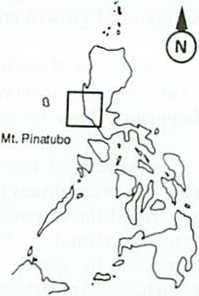
Fig. 1. Spot Image of Mt.
Plnatubo before eruption.
(This page's photos cour-
tesy of M.P. Atrigenlo,
P. Allfio and R. Bifia)
Introduction
MountPinatuboin north-
western Philippines
had been dormant for
six centuries. Iteruptcd
again in June 1991.
The volcano’s ash and
pyroclastic flows almost buried
three surrounding provinces and
their infrastructure, making barren the
agricultural Iandsandhasteningtheclosurc
of the nearby American military base. A
strong typhoon worsened the effects.
Heavy rainfall created lahar, greatly
adding to the loss of human lives, livestock
and agricultural crops. The sadder
postscript to all of these is that, after the
damage to rice and to other crops,
notwithstanding the displaced families,
thecommunities Iivingaround the slopes
of Mt. Pinatubo may till barren lands for
years.
Fig. 2. MOS Image of Mt. Plnatubo after eruption.
Six months after that devastating
eruption, the Philippine government was
still resettling and rehabilitating the
affected communities, farms and
infrastructure. However, the fishing
industry and the marine environment
appear to have been neglected. The coastal
province OfZambalcs (Fig. 1 and location
map) seems the only one affected, and
little is known that there is also damage
to inland fisheries in the provinces of
Pampanga and Bataan . The Philippine
Department of Agriculture reported a
Mount
Pinatubo's
Effects on
Philippine
Fisheries*
CASILDA INFANTE-GUEVARA
ICLARM

fisheries loss of P30.4
million (USS 1.14 million
as of January 1992)
covcri ng an area of over
2,500 ha, but this figure
does not tell how gravely
this industry has been
affected. Reports on the
effects of Mt. Pinatubo
on Philippine fisheries
from the University of the Philippines
Marine Science Institute (UPMSI) and
the Philippine Council for Aquatic and
Marine Resources Development of the
Department of Science and Technology
(PCAMRD-DOST) providesomeinsights.
Coral Reef Survey
TheUPMSI, in collaboration with the
Haribon Foundation for the Conservation
• ICLARM Contribution No. 829.
NAGA, THE ICLARM QUARTERLY
More intriguing information
1. Citizenship2. How Low Business Tax Rates Attract Multinational Headquarters: Municipality-Level Evidence from Germany
3. Økonomisk teorihistorie - Overflødig information eller brugbar ballast?
4. Improving behaviour classification consistency: a technique from biological taxonomy
5. Brauchen wir ein Konjunkturprogramm?: Kommentar
6. The economic doctrines in the wine trade and wine production sectors: the case of Bastiat and the Port wine sector: 1850-1908
7. PROTECTING CONTRACT GROWERS OF BROILER CHICKEN INDUSTRY
8. Magnetic Resonance Imaging in patients with ICDs and Pacemakers
9. School Effectiveness in Developing Countries - A Summary of the Research Evidence
10. Equity Markets and Economic Development: What Do We Know